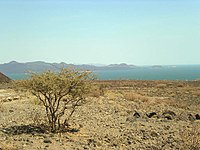| Sibiloi National Park | |
|---|---|
 | |
| Location | Rift Valley Province, Kenya |
| Coordinates | 03°57′38″N 36°20′33″E / 3.96056°N 36.34250°E |
| Area | 1,570.85 km2 (606.51 sq mi)[1] |
| Established | 1973 |
| Governing body | Kenya Wildlife Service |
| Part of | Lake Turkana National Parks |
| Criteria | Natural: (viii)(x) |
| Reference | 801bis-001 |
| Inscription | 1997 (21st Session) |
| Extensions | 2001 |
Sibiloi National Park lies on the northeastern shore of Lake Turkana in northern Kenya. Established in 1973 by the government of Kenya for the protection of wildlife and paleontologist sites there, it covers 1,570 km2 (610 sq mi)[1] and is internationally known for its fossils. It was listed as a UNESCO World Heritage Site in 1997 as a part of Lake Turkana National Parks.
Sibiloi National Park is located on the wild and rugged shores of Lake Turkana – the cradle of mankind - Sibiloi is home to important archaeological sites including Koobi Fora where the fossil remains have contributed more to the understanding of human evolution than any other site in the continent. The area is characterized by semi-desert habitat and open plains flanked by volcanic formations including Mount Sibiloi, where the remains of a petrified forest can be seen.[2]
- ^ a b World Database on Protected Areas – Sibiloi National Park
- ^ "Visit Africa: Sibiloi National Park, Kenya". visitafrica.site. Retrieved 2020-08-26.
